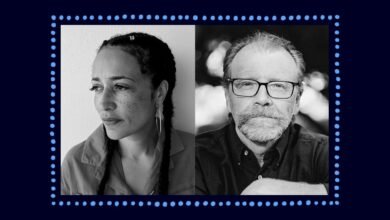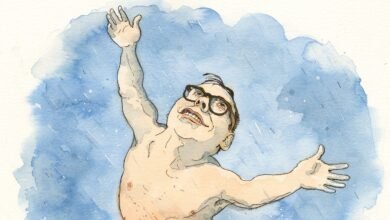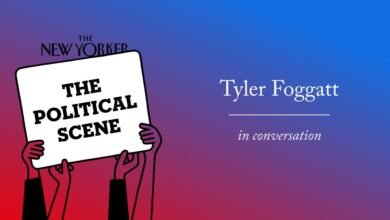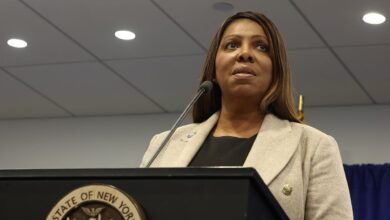
About midway through “Social Studies,” Lauren Greenfield’s new five-part FX docuseries about teens and their relationship to social media, we see one of the show’s protagonists—an eighteen-year-old University of Arizona freshman named Sydney—as she exercises on an elliptical machine at the gym. Wearing a gray tank top and black short shorts, with her hair tied back in a high ponytail, Sydney works out while striking poses for her phone camera and posting the images she captures to Snapchat. We watch all this from the P.O.V. of Sydney’s phone lens, and her living-my-best-life selfies fill our screen as she takes them, their stop-and-start rhythm matched by the immersive beat of the dance music that scores the scene. But then the soundtrack suddenly stops, and we turn to a full body shot of Sydney from a slight distance. Though she’s still exercising, still posing for the iPhone she holds aloft, her head cocked prettily in one direction and then the other, there is an almost comical chasm between the world that is recorded on her device and the world outside it. The illusion of energetic seduction is gone, and, instead, we are keenly aware of the dull labor that goes into creating it. With the music now silenced, Sydney’s ballet mécanique is accompanied only by the faint squeaking of the elliptical’s shifting gears.
The moment is signature Greenfield. Since the early nineteen-nineties, the Los Angeles-based photographer and filmmaker has been one of our most steadfast chroniclers of contemporary America’s excesses. Often immersing herself for considerable stretches of time in the lives and communities that she chooses to document, Greenfield is an empathetic and discerning observer, taking seriously the realities that her subjects construct for themselves while also shedding light on the areas that these constructed realities might overlook. In “Fast Forward” (1997), her first monograph, she documented teen subcultures in flashy, materialistic late-twentieth-century L.A., and, in her film and photo series “Thin” (2006), she followed young girls undergoing treatment at an eating-disorder clinic. Her film “The Queen of Versailles” (2012), focussed on Jacqueline (Jackie) Siegel, the wife of a Florida time-share magnate hit by the 2008 financial crisis, whose attempt to build the largest single-family home in the United States ends in disaster. In the monograph, museum exhibition, and documentary “Generation Wealth” (2017), she culled material from the course of her career to portray the unslaked American hunger for money and luxury.
In her projects throughout the years, Greenfield has consistently examined our culture’s championing of surface over substance—the way things look rather than the way things are. “Social Studies” fixes on a new incarnation of this problem, by turning to Gen Z’s use of social media. Sydney is one of a dozen or so teens that Greenfield followed during the 2021-22 school year, using, as she has in the past, a combination of first-person interviews and fly-on-the-wall documentation. Crucially, however, this project includes another type of footage: material sourced from her protagonists’ phones, which is intercut with the live action that takes place onscreen. The documentary proceeds, then, on two levels, to suggest the bifurcation experienced by its subjects, who are almost never not toggling between the IRL and the virtual worlds. “The kids gave us access to screen-capture their phones while we were shooting, so in effect their phone functioned like an additional camera,” Greenfield told me recently over Zoom. Though some of the teens might have at first attempted to curate their online interactions for the benefit of the documentary, as time went on, they became more and more amenable to telling their stories honestly through their social-media usage. “The access we got to the phones was a really important part of the series creatively, narratively, substantively. Just to understand what [social media] is and how it affects teens, we have to see it and read it and watch it,” Greenfield said. “This is a story that people haven’t seen before, and it’s a story that needed to be told, and it was important for the kids to tell it, too. They participated with a sense of purpose.”
A typical scene in “Social Studies” might center on a real-life interaction between two teens who are, say, hanging out and smoking weed at a park, but might also include the Instagram or Snapchat stories that they’re showing each other, or TikToks that they’re each scrolling through, or a shot of a selfie that they’re taking together, a series of D.M.s one of them is exchanging with an offscreen peer. All this makes for a viewing experience that manages to capture the hectic, surveilling, A.D.H.D.-style life so many of us—and especially young people—live nowadays. Social media’s addictive algorithmic pull, and the fact that it doesn’t have an off switch, means that kids find it very difficult to escape from its negative manifestations: cyberbullying, slut-shaming, toxic comparing. “People are going to watch this and think how dystopian and far gone our world is,” a girl named Stella tells Greenfield in an interview.
As I watched the series, I did feel that it occasionally struck an alarmist tone that reminded me of past “What has happened to our children?”-style teen-centric texts: Larry Clark’s “Kids,” Catherine Hardwicke’s “Thirteen,” and, most recently, Sam Levinson’s “Euphoria” (a show that gets mentioned more than once by Greenfield’s protagonists). In a sense, being worried about the waywardness of a younger generation has been a part of American culture at least since F. Scott Fitzgerald’s tales of the flapper twenties. Greenfield, however, believes that social media and the profit-at-all-costs tech companies behind it have made things unprecedentedly difficult for teens. “I think kids are still the same, but everything is amplified,” she told me. “Take the eating-disorder thing. When I made ‘Thin,’ one in seven girls had an eating disorder. When I started this project, one girl told me, half of my friends have an eating disorder from TikTok and the other half are lying.” She went on, “The stakes are higher now. All the mistakes you make are public, and they last. . . . Everything is faster, and innocence is lost earlier . . . and in a way, kids are more vulnerable because they have fewer opportunities to learn how to deal with things in the real world.”
Greenfield turned to developing “Social Studies” during the early pandemic, after noticing that her younger son, then fourteen, was becoming negatively affected by his inability to communicate with his peers in person. “He’d be on his screen all day, and he’d become sort of ornery or depressed,” she said. “And he was very private about it. He didn’t share with me. I started getting curious about what this thing was that the kids were on so much.” She began shooting the series when schools in Los Angeles started to reopen: the series kicks off on the first day of in-person attendance at the Palisades Charter High School in the swanky Pacific Palisades neighborhood on L.A.’s Westside. “I ended up including students from other schools, too, but I started with Pali because it’s a public school in a rich area that draws from a hundred Zip Codes, so, even within that one school, the student body is very diverse,” Greenfield said. “I didn’t want it to be about one particular kind of kid.”
The kids Greenfield focusses on run the gamut of class and race. Among them are Sydney, who before going to Arizona for college developed a following for her sexy social-media content and was slut-shamed at Pali; Keshawn, an aspiring d.j. and musician from Inglewood who dreams of success as a TikTok star, and ends up having a child at seventeen with his girlfriend; Ellie, a girl from Mid-City who’s consistently drawn to wealthier, whiter peers from the right side of the tracks; Jack, a party promoter who uses social media to develop various business schemes; Ivy, a Santa Monica teen who struggles with feelings of isolation and has a trans sister and a conspiracy-theory-pilled mother; Sophia, a girl who was raped by a fellow-student and seeks out help from a boy named Anthony, who’s known for calling assaulters out on social media; Cooper, a perfectionist Brentwood teen whose body-image issues have been amplified by online life; Stella, an arty girl who went viral on TikTok in the wake of a suicide attempt; and Jonathan, who volunteers at a teen helpline, is making his own documentary about his peers, and longs to get into Yale.
For these kids, the way things appear on social media is often more important than the way they are in so-called real life. “You start a TikTok to be in that TV-show, movie-type life where everything comes easy for you,” Keshawn says. Cooper notes, of the lure of Facetune, “I want to look like that. I don’t want to look like the real picture.” Many of the teens realize that social media is linked to eating disorders and suicidality, and they are certainly aware that it makes them feel like shit—“Gen Z isn’t doing well because of this,” Cooper says—and yet, it’s very difficult for them to let go. As Stella says, “there’s something really addictive about looking at what you desire.”
Being a part of Greenfield’s documentary, however, seems to have provided the teens with a measure of relief. Built into the episodes are group meetings that Greenfield held throughout the year at an off-site school library. Much like the consciousness-raising session at the heart of the eighties movie “The Breakfast Club,” these gatherings allowed the series’ participants to share their woes, only in this case, of course, social-media was at the forefront of the discussions. “The commonalities were striking,” Greenfield told me. “They’re really different, but you can see that they all have the same problems.” The fact that phones weren’t allowed in the room made the experience all the more valuable, not to mention rare. “I never have this depth of conversation with anybody in my life,” Cooper says, in the group’s final meeting, and Ivy agrees: “I think that the absolute best thing we can do is to really . . . try to genuinely connect with others outside of social media, because liking and commenting on their posts is a sorry excuse for a relationship.” Still, the teens are aware that it would be difficult, maybe even impossible, to replicate this kind of experience in the real world. “How do you get off social media without people forgetting you exist?” Cooper wonders. For these kids, letting go of online life, more often than not, feels tantamount to letting go of life itself. ♦
Source link







